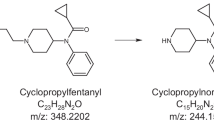Abstract
Purpose. A subpopulation of the CF-1 mouse strain (approximately 25%) lacks P-gp expression, and consequently, increased brain penetration of many substrates is observed in these animals. Mice lacking the mdr1a gene represent an important research tool to study the potential effects of P-gp on CNS substrate disposition.
Methods. Adult CF-1 mice were used in all experiments. Loperamide-induced antinociception was determined by the hotplate latency test at 0.25, 2, and 4 h post-dose. At the conclusion of the pharmacodynamic experiment(s), trunk blood and brain tissue were collected and analyzed by high-performance liquid chromatography-mass spectrometry (LC-MS/MS). Mice were also genotyped for their mdr1a status via RT-PCR.
Results. All mice with three consecutive effects of maximum hotplate latency (60 s) showed considerable opioid-like behavior in addition to antinociception. Mice without three consecutive effects of maximum hotplate latency (≤30 s) showed no opioid-like behavior. The loperamide brain-to-serum ratio in mice identified as P-gp-deficient was 65-fold higher compared to the P-gp-competent animals (10.1 ± 1.0 vs. 0.155 ± 0.018). All animals identified as phenotypically P-gp-competent based on the hotplate assay evidenced the mdr1a(+/+) genotype.
Conclusion. This assay appears to offer a rapid and unambiguous measure via a relatively non-invasive, simple technique to identify P-gp status in the CF-1 subpopulation of mice.
Similar content being viewed by others
REFERENCES
R. L. Juliano and V. Ling. A surface glycoprotein modulating drug permeability in Chinese hamster ovary cell mutants. Bio-chim. Biophys. Acta 455:152–162 (1976).
P. L. Golden and G. M. Pollack. Blood-brain barrier efflux trans-port. J. Pharm. Sci. 92:1739–1753 (2003).
V. Ling. Multidrug resistance: molecular mechanisms and clinical relevance. Cancer Chemother. Pharmacol. 40:S3–S8(1997).
P. F. Juranka, R. L. Zastawny, and V. Ling. P-glycoprotein: multidrug-resistance and a superfamily of membrane-associated transport proteins. FASEB J. 3:2583–2592 (1989).
D. R. Umbenhauer, G. R. Lankas, T. R. Pippert, L. D. Wise, M. E. Cartwright, S. J. Hall, and C. M. Beare. Identification of a P-glycoprotein-deficient subpopulation in the CF-1 mouse strain using a restriction fragment length polymorphism. Toxicol. Appl. Pharmacol. 146:88–94 (1997).
A. H. Schinkel, J. J. M. Smit, O. van Tellingen, J. H. Beijnen, E. Wagenaar, L. van Deemter, C. A. Mol, M. A. van der Valk, E. C. Robanus-Maandag, H. P. te Riele, A. J. Berns, and P. Borst. Disruption of the mouse mdr1ap-glycoprotein gene leads to a deficiency in the blood-brain barrier and to increased senstivity to drugs. Cell 77:491–502(1994).
P. Borst, A. H. Schinkel, J. J. M. Smit, E. Wagenaar, L. van Deemter, A. J. Smith, E. W. H. M. Eijdems, F. Baas, and G. J. R. Zaman. Classical and novel forms of multidrug resistance and the physiological functions of p-glycoproteins in mammals. Phamac. Ther. 60:289–299 (1993).
M. Narita, T. Suzuki, M. Misawa, and H. Nagase. Antagonism of the morphine-induced Straub tail reaction by k-opioid receptor activation in mice. Psychopharmacology (Berl.) 110:254–256 (1993).
C. Chen and G. M. Pollack. Blood-brain disposition and antino-ciceptive effects of-D-penicillamine2,5-enkephalin in the mouse. J. Pharmacol. Exp. Ther. 283:1151–1159 (1997).
T. R. Pippert and D. R. Umbenhauer. The subpopulation of CF-1 mice deficient in P-glycoprotein contains a murine retroviral in-sertion in the mdr1a gene. J. Biochem. Mol. Toxicol. 15:83–89(2001).
A. H. Schinkel, E. Wagenaar, C. A. Mol, and L. van Deemter. P-glycoprotein in the blood-brain barrier of mice influences the brain penetration and pharmacological activity of many drugs. J. Clin. Invest. 97:2517–2524 (1996).
A. J. Sadeque, C. Wandel, H. He, S. Shah, and A. J. Wood. Increased drug delivery to the brain by P-glycoprotein inhibition. Clin. Pharmacol. Ther. 68:231–237 (2000).
C. Pauli-Magnus, J. Feiner, C. Brett, E. Lin, and D. L. Kroetz. No effect of MDR1 C3435T variant on loperamide disposition and central nervous system effects. Clin. Pharmacol. Ther. 74:487–498 (2003).
C. Skarke, M. Jarrar, H. Schmidt, G. Kauert, M. Langer, and G. Geisslinger, and J. Lotsch. Effects of ABCB1 (multidrug resis-tance transporter) gene mutations on disposition and central ner-vous effects of loperamide in healthy volunteers. Pharmacogenet-ics 13:651–660 (2003).
G. R. Lankas, M. E. Cartwright, and D. Umbenhauer. P-glycoprotein deficiency in a subpopulation of CF-1 mice en-hances avermectin-induced neurotoxicity. Toxicol. Appl. Phar-macol. 143:357–365 (1997).
Author information
Authors and Affiliations
Rights and permissions
About this article
Cite this article
Kalvass, J.C., Graff, C.L. & Pollack, G.M. Use of Loperamide as a Phenotypic Probe of mdr1a Status in CF-1 Mice. Pharm Res 21, 1867–1870 (2004). https://doi.org/10.1023/B:PHAM.0000045241.26925.8b
Issue Date:
DOI: https://doi.org/10.1023/B:PHAM.0000045241.26925.8b




